Posts tagged with Track from Scratch
Here you can find a listing of all posts with the tag Track from Scratch on my page.
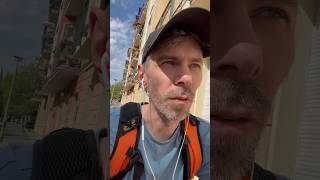
Aug 21, 2023 Tutorial
The video advises against overthinking and encourages taking action instead. It suggests that starting something and not worrying about the outcome is important. If I don't like what I've started, I can simply start fresh and try something new. The process of doing, practicing, and gaining new information can lead to improvement over time. Eventually, I may even realize that what I had initially thought was not so bad after all. The key takeaway is to take action and avoid overthinking.
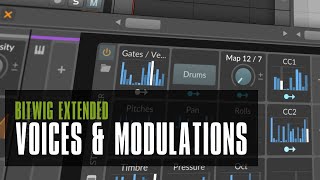
Jul 05, 2023 Tutorial
In this video, I share two tricks for Bitwig Studio that can be used in certain situations. The first trick is about creating unison in devices or synthesizers that don't have a built-in unison feature. By duplicating the input notes and assigning them to different MIDI channels with slightly different pitches, you can create the effect of unison. I demonstrate how to do this using the note grid and show how to adjust the pitch and panning for each duplicated note. By using this trick, you can achieve a chorus-like effect and stack multiple voices. The second trick is useful for performing with generative patches or creating evolving sounds over time in Bitwig Studio. I show how to modulate the intensity of modulation parameters using the intensity output of a macro. By selecting the modulation target in the synthesizer and clicking on the modulator handle, you can access a second amount slider that allows you to control the modulation amount. This can be helpful for adding dynamics and variation to your performances or arrangements. Overall, these tricks can expand your creative possibilities in Bitwig Studio and I hope you find them helpful.
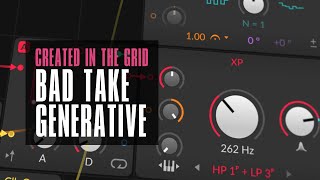
Jan 26, 2023 Tutorial
In this video, I'm showing viewers how to create music from scratch using tools such as the polygrid, kick drum synthesis, noise module, filter, distortion, chorus, mod delay, step mode, auto level, ducking, wave folder, reverb, dice, clap, white noise, envelope follower and diva. I'm also demonstrating how to sprinkle samples on top for an organic sound. At the end, I offer viewers the chance to download the track on my Patreon page.
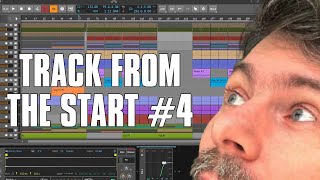
Jun 27, 2022 Tutorial
I created a drum and bass track from scratch in this video. I started by adding a snare to a sampler and then adding a kick drum and some hi-hats. Then I created a bass line by modulating the oscillator and adding a beat limiter and a step mod. After that I added a pad sound with some modulation and a delay. I then added some more drums and a crash. I then added a clap and used a filter to make the kick and bass stand out more in the intro. Finally, I added a micro pitched synth and faded out the pad for the outro.
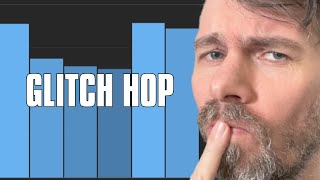
Apr 11, 2022 Tutorial
In this video, I show how to create a Glitch-Hop track using a drum machine, bass lines, and multiple layers of instruments. I explain how to use a ramp mod and how to switch between layers with instrument selectors and step mods. I also explain how to use note repeats, quantizers, and effect zones. Finally, I show how to use a click filter to get the kick drum out of the drum machine.
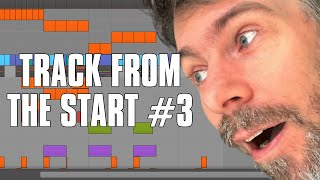
Apr 07, 2022 Tutorial
I am creating a drum and bass track and I am starting with the bass. I am using FM8 and mixing in two oscillators and adding a bit of noise and distortion. I'm then moving on to the drums, using a kick and snare, and then a shaker and ride. I'm using the transient shaper and hard clip to level out the sounds and then I'm creating a sidechain with the kick, so that it removes the bass when the kick plays. Lastly I'm creating a step sound with a Polysynth and adding in a crash sound.
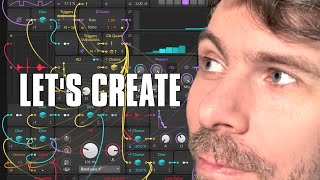
Apr 06, 2022 Tutorial
In this video, I showed how to build a self-running grid patch in Bitwig Studio. I started by selecting the grid and setting it to monophonic mode. I then connected a trigger to a phaser and an XP filter, and then used a face in to create notes. I added a sample and hold, a dice module, and a reverb to the patch. I also added a pitch signal to switch between an octave higher or lower. Finally, I used a global shuffle to change the pattern.
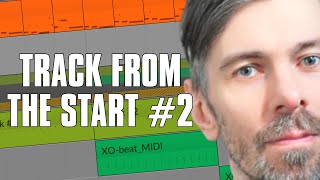
Mar 22, 2022 Tutorial
In this video, I created a music track using a synth, a reverb, a delay, a key filter, a note rap device, a quad track, an arpeggiator, a chorus device, a quad bass, a portal, percussion and drums, a lead sound, modulation and automation, and a half time. I randomly modulated the sounds and added some distortion, reverb, and a transient shaper to bring out the spaces. I then layered some triggers and hi-hats to create a nice combination. Lastly, I used a filter and a phaser to give it a final touch.
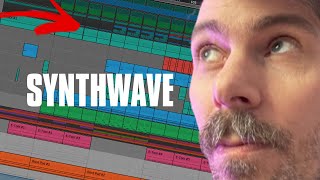
Feb 11, 2022 Tutorial
In this video, I show how to create a simple SynthWave track in Bitwig Studio. I demonstrate how to create a dreamy lead sound, a bass sound, and a drum beat. I also discuss how to use a breath controller and arpeggiator to make the track more interesting. Additionally, I talk about how to use a VHS preset and a texture plugin to add texture and atmosphere to the track. Finally, I show how to arrange the track into a cohesive song.
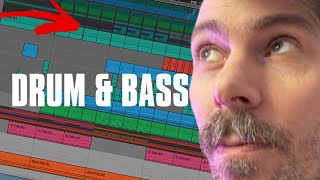
Nov 18, 2021 Tutorial
In this tutorial, I explained my thought process for producing drum and bass inside the studio from start to finish. I started with the bass first, and explained how I use smooth ball synths to create the bass groove, which then influences the pattern of the drums. I also shared some tips on how to create interesting patterns, such as using automation and steps mode to modulate the pitch, LFO and ADSR. Finally, I explained how to use reverb, distortion, chorus, and EQ to add effects to the bass and create a unique sound.
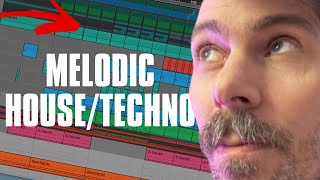
Oct 26, 2021 Tutorial
In this video, I produce a melodic techno or melodic house tune inside Bitwig Studio. I start from zero with no idea what to do and end up with a track that is 7 minutes long. I use a variety of techniques such as automation, modulation, sound design, mixing, arranging, and keeping the sequence interesting. I show how to create a root drone, how to use an instrument, how to apply audio effects, and how to use a step modulator. I also demonstrate how to use an LFO, an EQ, and a reverb device.
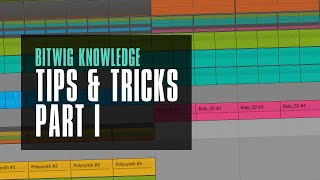
Apr 28, 2020 Tutorial
In this video, I share some additional tips and tricks for using Bitwig Studio. I first show how to use the browser tab to import recent projects or specific groups within a project. Next, I demonstrate how to use the key track to modulate the frequency of an EQ or filter to correspond with MIDI inputs. I explain how to bounce audio with or without effects included and why I prefer using the bounce option over bounce in place. Finally, I share how to deactivate tracks for faster loading time and how to hide source material tracks. Overall, these tips can improve your workflow in Bitwig Studio.
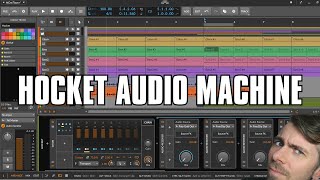
Mar 27, 2020 Tutorial
In this video, I show how to create a hocket machine in Bitvic Studio using audio receivers and modulation. I use a track called "hocket" with a classic 8 modulator and multiple audio receivers that receive audio from different tracks. To prevent unwanted noise, I adjust the smoothing value when switching between audio sources. I also demonstrate how changing the playback speed, time base, phase modulation, and direction can create different grooves and patterns. I use unusual rhythms on all the tracks to create a more drastic effect. The limitation of this system is that it only has eight steps in the classic 8 modulator. Overall, this effect is easy to setup and can create some interesting outcomes in a track.
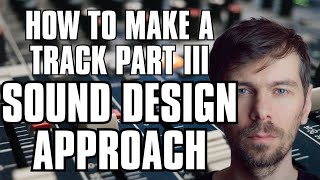
Mar 18, 2020 Tutorial
In this video, I show viewers how to use a sound design approach to create music in Bitwig Studio. We start with a generative patch to create random patterns of notes and sounds. Then, we bounce this out as an audio file and use it as a sample source. We add a simple kick drum pattern and use an audio sidechain to modulate the amplitude of the music group. Next, we create a bassline using the Phase-4 device and add a Classic LFO and FX2 device for added effects. We bounce out the created sounds and create collages of these sounds to keep the track interesting. This approach doesn't focus on harmony or chords but rather heavily relies on the sound itself. You can create more sounds and variations to make the song even more interesting. Overall, this is a sound design-based approach to music creation in Bitwig Studio.
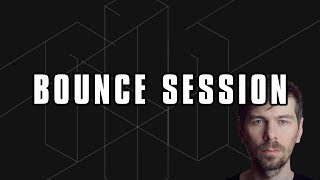
Jul 20, 2019 Tutorial
In this video, I take samples from the Intimate Noise page and try to create a track. I download the free sample pack and explore the different folders, including pads and drones, one shots, and sequences. I start by using the kick samples and creating a drum loop. Then, I incorporate some of the pad samples to add texture to the track. I manipulate the sounds using different effects and plugins, such as the Hornet plugin and the Sonable smart compressor. I also create a baseline using the notes provided by the pad sample. I continue to build the track by adding more elements, including chords, FX sounds, and melodies. I use a pitch shifter and random modulators to add character and variation to the sounds. I group the different elements together and apply sidechain compression using the kick drum to create a pumping effect. Finally, I do a quick mastering using the Allzone Elements tool to ensure the track reaches the desired loudness. Overall, the goal is to create a deep house track using the samples from the Intimate Noise sample pack.

Jul 13, 2019 Tutorial
In this video, I recreated the Stranger Things theme using Bitwig Studio. I also collaborated with a friend to recreate the intro, resulting in Prolavity Things'. All the tracks in the project were created using Bitwig only, including an E-kick, polyscent, and a sampler with my voice. I also showcased the Bitwig 3.0 tape machine preset that I made for the master track. The project does not use any dynamic processors, only a peak limiter at the end. I recorded my voice for some portions of the track. I provided the project download link in the description. Additionally, I mentioned the Bitwig Outrun Challenge for creating and sharing Retro Wave or Synthwave presets. The challenge is for fun and there are no prizes involved. Thanks for watching and see you in the next video.
More Tags to choose from:
posts Bitwig Deutsch Tutorial FromScratch bitwig-guides Audio-FX articles Guidelines Webtool Tempo Talk Skyence Chords music-videos Brain Neurosience German Knowledge PDF Ambient Hardware Jam Music Drum-and-Bass fawm Behringer Moog Mixtape release Polarity Bandcamp polarity-music Frequency Modulation Phase Modulation synthesizers Video Editing Gravity Modulator Grid Sampling Presets Glitch-Hop Generative Plugins Sound-Design Rhythms oscillators Modulation Bass Synthesis Update Preset Community Modulator Synth Midi Step-Sequencer Granular FX Automation Wave Table Synthesizer FX Section Lab Update music-production Let-It-Go Decision-Making Creativity Synths Melodies Modulators Note-Grid Percussion MPE Controllers Delay Resonator Kick Drum Pads Synthwave Track from Scratch Outrun Challenge Additive-Synthesis Mixing Delay-plus Reverb Filter Noise Resonance Auto gain staging Hornet LU meter Normalizer Sketch VSTs Loudness Modular Workflow Opinions Groove Audio-Effects Poly-Grid Bitwig-3.2 Bitwig-3.1 Replace VST Note-FX Poly-Synth MPE Roli Tips-Tricks Polyphonic Racism Music Industry Social Issues Equality Inspiration Physical-Modeling Synthesizer Live streaming Discord bot Interaction Convolution Sampler Grain Evolving-Sounds Distortion Sonible Analysis EQ-plus fm-synthesis Drums Compressor Feedback EQ Glitch Comp Filter Ultra Reservoir Polyphonic Mode VCV-Rack Polysynth Peak Limiter EQ-5 Comb Filter Modal Synthesis Wave-Shaping Saturation Follower Threshold Max Value EQ-2 FX-Grid Mid-Side Split Bitwig-3.3 Bitwig-4.4 Infiltrator Devious-Machines Randomization Atlas Pitchmap Zynaptiq Unfilter Bespoke DAW Harmony-Theory Melodic-Techno Transposer MinimalAudio XLN-Audio XO Sononym Cosmos Transient-Shaper Arturia Valhalla FM8 Native Instruments Bleass Psych Limitation Clap Extension free Eurorack Grid-From-Scratch Diva Monark Arrangement Pure-Verb Pure-Comp Pure-Limit Gridnik Risers Transitions Instrument Launchpad dpMeter tbProAudio Micro-Arrangement Global-Modulators Workflow-Tips Vector Synthesis Waveforms Phaser Polymer Wavetable Bleass Voices Bitwig Studio Plugin Pitch Shifter Vocoder MIDI Input Recording Learning Problem-Solving Research wisdom Psychology Plug-ins Gear Polygrid Wave Table Interface OpenSource PlugData Clever-Audio-Plugin-Clap Sidechain Compiler VST-Plugin Heavy-Compiler Current Effects Formant SynPlant AI download FM-synths machine-learning soniccharge Sound-Generator Granular-Synthesis Pitch Vector XY-Instrument Touch-Designer Video-Edit Visuals Beginners Bitwig-5.1 Sync Signals xlnaudio additive Sequencer Euclidean Bitwig-5.1.2 No-Grid Stock Jazz Finishing-Songs Thoughts Browser Techno Polyrhythm Polymeter M1 Clip-Launcher AudioThing Lese Routing Spectral tests paulxstretch Triton Utility Analogue Grains Patreon Bitwig-5.1.6 Kilohearts Bitwig-1.3.16 Project Theming Bitwig-5.1.7 Bitwig-5.2b1 Giveaway Amiga Tegeler Bitwig-5.2b5 Filters Keytracking Bitwig-5.2b2 Ableton Segments zplane Bitwig-5.2b7 Trance Bitwig-5.2b8 Calculations Shift-Register Bitwig-5.2b10 Markov Bitwig-5.2b11 Dynamics Bitwig-5.2b12 Bitwig-5.2 Bitwig-5.2b13 Voice-Stacks















